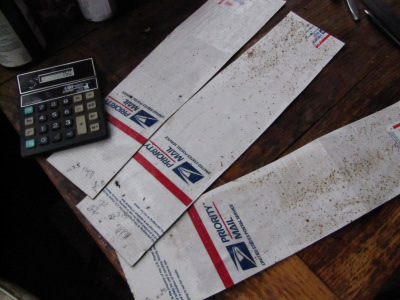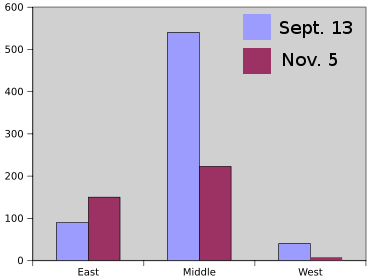
Testing for varroa mites
 I
was a bit concerned by the bee hive that dropped 540 varroa mites in
three days when I tested
in the middle of September, so I decided to do a
re-test and see what the mite populations are like in early
November. This time, all I had on hand were some four inch wide
strips of cardboard that are a byproduct of the way we package our pre-made
chicken waterers, so
I went ahead and lathered those with petroleum jelly and stuck them
under the screened bottom boards of our hives.
I
was a bit concerned by the bee hive that dropped 540 varroa mites in
three days when I tested
in the middle of September, so I decided to do a
re-test and see what the mite populations are like in early
November. This time, all I had on hand were some four inch wide
strips of cardboard that are a byproduct of the way we package our pre-made
chicken waterers, so
I went ahead and lathered those with petroleum jelly and stuck them
under the screened bottom boards of our hives.
 Three
days later, I counted mites and did a bit of math to determine what the
total mite fall would have been if I had put something under the entire
bottom board. As you can see from this graph, the hive with all
of the varroa mites in September dropped down to a far more manageable
level (223 mites) in November. None of the other hives have mite
populations in the danger zone at all.
Three
days later, I counted mites and did a bit of math to determine what the
total mite fall would have been if I had put something under the entire
bottom board. As you can see from this graph, the hive with all
of the varroa mites in September dropped down to a far more manageable
level (223 mites) in November. None of the other hives have mite
populations in the danger zone at all.
Most sources report that
mite numbers rise as autumn progresses, so I'm not quite sure why I saw
declining varroa mite numbers. I assume that as workers die and
aren't replaced, the hive hosts fewer varroa mites as well.
Regardless of the reason for low mite populations in my hives, I'm
happy to be heading into the winter without chemical pesticides in the
hive.
Want more in-depth information? Browse through our books.
Or explore more posts by date or by subject.
About us: Anna Hess and Mark Hamilton spent over a decade living self-sufficiently in the mountains of Virginia before moving north to start over from scratch in the foothills of Ohio. They've experimented with permaculture, no-till gardening, trailersteading, home-based microbusinesses and much more, writing about their adventures in both blogs and books.
Want to be notified when new comments are posted on this page? Click on the RSS button after you add a comment to subscribe to the comment feed, or simply check the box beside "email replies to me" while writing your comment.
